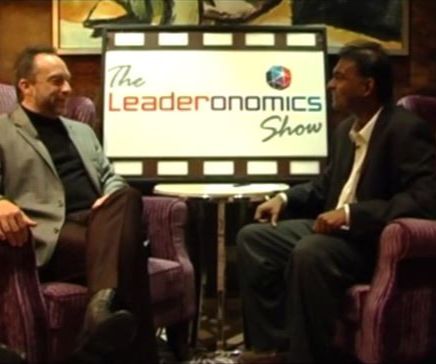Tweak The Environment

Last year, I started to get worried about my employees at Leaderonomics. I noticed that they were interacting less with each other; many opting to work from home instead (we practise flexi-work policies). I recalled many occasions, late into the evenings, when Hui Ming (our co-founder) and I were the only people in the office.
Part of the problem was that we had grown so fast, doubling our headcount in a few months, causing significant space congestion. But my bigger concern was similar to that shared by Google – a lot of the great ideas and initiatives is a direct result of casual discussions among employees. Google believed that casual employee conversations were responsible for innovations such as Gmail and Street View. Like me, Google believed it was critical to ensure employees were at the office interacting with each other daily. Whilst working at home is great for work-life balance, it does nothing to help ideation and creativity.
I faced a significant challenge. It had become habitual for people to work from home. I could mandate that people work from the office but this would have resulted in very unhappy employees. This is as evidenced from Yahoo, where chief executive officer Marissa Mayer’s mandate for all employees to be at the office had created numerous issues and tension. So, knowing this fully well, we decided to tweak the environment instead.
No Place like ‘Home’
We built a new office that felt like home. Just like home, everyone had to remove his/her shoes before entering the premise. We even attached fake grass on certain parts of the floor to ensure a homely feel. The result – without any mandate, employees started making the office their home. They stayed on late, had casual conversations with each other as if they were part of a family and frequently stayed overnight at the office interacting and ideating. (BTW- within a year, the Leaderonomics office was named the top 10 most Inspiring offices in the country)
There was no policy change. Nor was there any mandate. Just a small tweak in the environment drove a change in behaviour. How is this possible?
Shaping a Path
I recently read a great book by brothers Chip and Dan Heath entitled Switch. The brothers constantly heard people saying that “change is hard” and “people hate change”. Interestingly to them, if change was hard, they wondered why people joyously embrace change daily – like getting married, or having children, or getting a new phone.
On the contrary, they wondered why some trivial changes, like submitting an expense report on time, are often met with fierce resistance. Their research concluded that our brains have two “systems” – a rational and an emotional system. When these two systems are in alignment, change comes easily, and when they’re not, change can be gruelling.
So how does one reach this alignment? According to the brothers, one of the ways to achieve this alignment is to “shape a path”. They believed that if we change the environment so that a new path is created, most people will follow the new path.
Cool People Sit in Front?
In their book, they provide an example of a history teacher (Bart Millar) who was frustrated by two students who frequently came late and were constantly disrupting the class. Most teachers would have assumed that these two students were “bad apples” and kick them out of the class. But Millar assumed otherwise. He believed that the reason they were late and disruptive was due to the environment. Cool students sit at the back of the class. Cool students have a delusion that their disruptive behaviour makes them class “protagonists”.
So, he decided to “tweak the environment”. He bought a cool couch and put it in front of the classroom. The first students to the class daily could sit on the couch (and slouch). Guess who immediately started coming early to class? His two disruptive students came early each day and “volunteered” to sit in front of the class.
People are NOT the Problem
Research clearly shows that people are generally not the root of problems. Situations are. Most of the time we attack a problem by assuming that it is a people problem. According to famous Stanford psychologist Lee Ross, people are frequently blinded to the power of situations. He instead attributes what he terms as “fundamental attribution error” to people.
His research concludes that we tend to attribute people’s behaviour to “the way they are” instead of “the situation they are in”, which is the most likely factor. A number of years ago, I was running an organisation which was a joint venture (JV) between a global multinational corporation (MNC) and a government-owned company. The culture of the organisation was modelled after the local organisation, where there was minimal growth, and the environment facilitated low productivity. Employees constantly took smoking breaks and were totally unmotivated to improve or support business growth.
In fact, whenever we had new work coming in, most of the employees got extremely upset. As I walked into this new company, it would have been easy for me to look around and blame the people. Having worked in a global company, it was clear that the quality of the people was the main cause of the poor performance of the company. Instead of taking out my “chopping block” and starting to “bring in better people”, we decided to “tweak the situation”.
What if Lee Ross was right and the real issue was not the people but the situation?
How a Fence Made A Difference
We started our “transformation” programme by doing the oddest thing – we built a fence. As this JV was situated in the midst of the local company’s operation, the culture of the low-productivity local partner became the dominant culture of this new JV company. By building a fence, we tweaked the environment in the hopes of creating a new high performance culture. In a matter of weeks, we saw surprising results. Smoking breaks became less frequent as it was very inconvenient to smoke inside this new fenced entity.
We started driving new initiatives and people seemed to respond. Within two years, we became one of the most productive organisations in the world in that industry. The fence had done wonders!
Tweaking the environment is about making the right behaviour a little bit easier and the wrong behaviour a little bit harder. Peter Gollwitzer, a professor of psychology, argues that most people preload decisions with no conscious deliberation. When people pre-decide, they “pass the control of their behaviour on to the environment”. So, how do leaders design an environment in which undesired behaviours are made not only harder but impossible?
Tweaking the Apple
In 1992, there were 2,154 murders and 626,182 serious crimes committed in New York City. Within five years, New York City murders had dropped almost 70% and serious crimes dropped by 50%. I happened to be working and living in the city at that period and witnessed the transformation from a dangerous city into one of the safest cities.
How did its crime rate drop within a short period to an all-time low? The simple answer: tweaking the environment.
The team at New York City focused only on eliminating petty crimes and fixing all broken windows and graffiti in the city. They worked tirelessly to clean all graffiti in the subways. With the subways looking cleaner and petty crime reduced, it created an impression that crime was not part of the environment of the city. Soon, the bigger crimes disappeared.
Setting the Scene
Generally, great leaders don’t immediately assert the culpability of undesired behaviour to “bad people”. Instead of solely blaming their people, they think, “How can I set up a situation that brings out the good in these people?” Remember, when the situation changes, behaviour changes too. So change the situation.
According to the Heath brothers, “tweaking the environment” can be as simple as moving your alarm clock to the other side of your bed so that you won’t be able to hit the snooze button easily. To encourage yourself to exercise in the morning, instead of wishing to be healthy, try laying out your gym clothes at night so that it is the first thing you see when you get up. Simple tweaks may yield significant returns not only for business leaders, but also individuals.
Final Thoughts
Big problem, small solution. Big problems are rarely solved with complex solutions. Often, they are solved by a sequence of small solutions. Just like how New York City solved its massive crime problems through smaller interventions, tweaking your environment may be a far superior solution than implementing a big drastic change.
The bigger question: Can you design an environment in which all undesired behaviours are made harder, whilst desired behaviours become the norm?
If you do so, you are on to something great – driving change the easy way!
Editor's Note: Our indoor grass may not be real, but the camaraderie and connectedness at Leaderonomics is very much so!
Watch this great video on how you can tweak your environment with technology:
At Leaderonomics, we really believe that organisations can design (even from work-from-home situations!) a culture and structure that directly causes employees to behave in a certain way. Check out the new show on psychology called Psyched where Roshan Thiran discusses the Stanford Prison experiment and how by tweaking the environment, people become evil within a few days. To watch the show, click here.
There are some great HR tech tools, including Happily and Budaya, which can be used to intelligently develop your culture and environment virtually. To leverage these tools or to connect with Leaderonomics, email us at info@leaderonomics.com
Leadership
Tags: Be A Leader
Roshan is the Founder and “Kuli” of the Leaderonomics Group of companies. He believes that everyone can be a leader and "make a dent in the universe," in their own special ways. He is featured on TV, radio and numerous publications sharing the Science of Building Leaders and on leadership development. Follow him at www.roshanthiran.com





